Explore The Iconic Art At The Guggenheim Museum In Bilbao In 2025
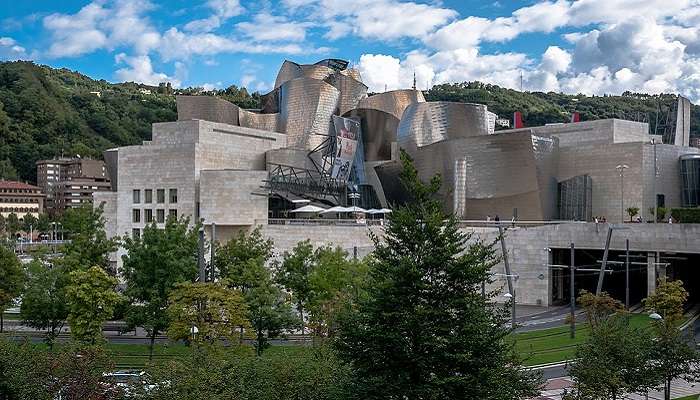
The Guggenheim Museum in Bilbao sits perched on the banks of the Nervión River, floating between modern art and cutting-edge architecture. With its appearance of twisted metal, the titanium-clad masterpiece designed by Frank Gehry and opened in 1997 transformed the once-industrial city of Bilbao into a cultural icon. Before you even step inside, it captivates visitors with undulating forms and gleaming surfaces. An impressive collection of contemporary and modern art is housed in the museum. Along with Jeff Koons’ flower-covered ‘Puppy’ guarding the entrance (although its concrete nature suggests otherwise), Richard Serra’s monumental steel sculptures within the Guggenheim Bilbao offer an unprecedented journey through the avant-garde, indeed a journey that redefines what a museum is.
About Guggenheim Museum Bilbao

The Guggenheim Museum in Bilbao is one of the world’s most important museums of modern and contemporary art. It opened in Bilbao, Biscay, Spain. It is connected to the Solomon R. Guggenheim Foundation and presents both permanent and temporary collections and exhibitions of Spanish and foreign artists. Opened on October 18, 1997, by the King of Spain, Juan Carlos I, the museum began with a collection of 250 contemporary pieces.
It is here that the innovative museum by Frank Gehry, the Canadian-American architect, was built; it is located on the Nervion River, which empties into the Cantabrian Sea. Gehry’s work can be regarded as an exemplary work of putting postmodern architectural ideas into practice, thus acclaimed by experts, researchers and the general public. The Guggenheim was mentioned in the 2010 World Architecture Survey as one of the most important architectural works built since 1980. Thus, the building became an important cultural icon in Spain.
Also Read: National Parks Of Spain
History Of Guggenheim Museum In Bilbao
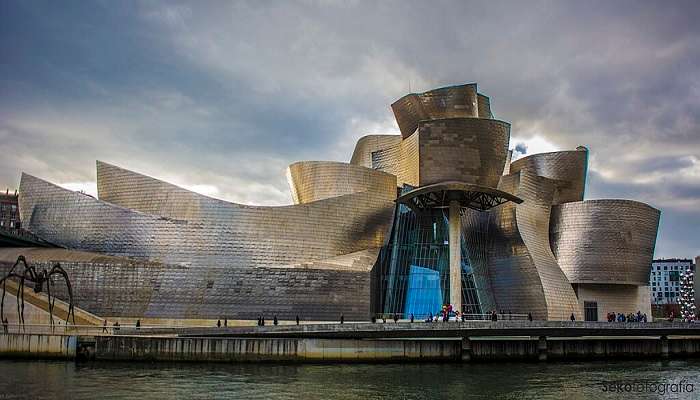
The Guggenheim Museum in Bilbao was founded following a 1991 proposal by the Basque Government to the Solomon R. Guggenheim Foundation to establish a museum in Bilbao’s deteriorating port area. The Basque government agreed to fund the $100 million construction cost, establish a $50 million acquisitions fund, and pay an annual budget of $12 million. In return, the Guggenheim Foundation would look after the museum, select a rotating choice from its permanent collection, and organise temporary exhibitions. The museum, built by Ferrovial for $89 million, opened on October 18, 1997, with an outdoor light show and concerts attended by about 5,000 residents. But violence marred the opening: just days before, two members of the ETA militant group had killed a Basque policeman trying to stop them from attacking the event.
In 2008, the museum announced it would expand by 5,000 m² in Urdaibai, an estuary east of Bilbao. The museum’s continued growth and importance in the region is evidenced by the €40 million that the Biscay provincial government promised to spend on this expansion by 2022. Today, the Guggenheim Museum in Bilbao stands not only as a centre for contemporary art but also as a vital element in Bilbao’s cultural and economic revitalisation.
Architecture Of Guggenheim Museum In Bilbao
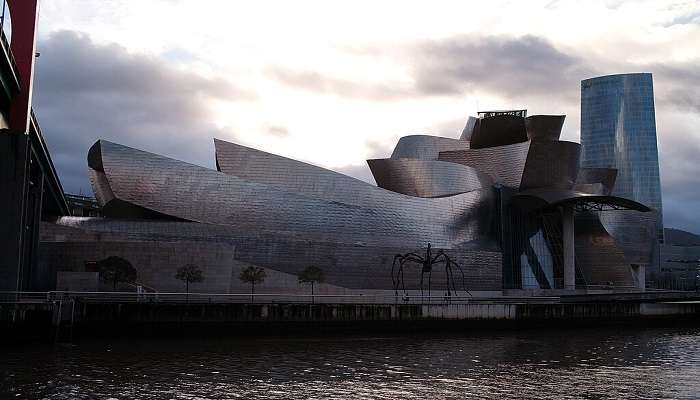
The Guggenheim Museum in Bilbao, designed by architect Frank Gehry, is a striking example of modern architecture characterised by its use of glass, titanium, and limestone. Selected by the Solomon R. Guggenheim Foundation, Gehry was encouraged to create a daring design that reflects the dynamic essence of contemporary art. The building’s exterior features random curves crafted to capture and reflect light, creating a mesmerising visual effect. At the heart of the museum is a spacious atrium, affectionately dubbed “The Flower” by Gehry for its unique shape. This light-filled central space offers stunning views of the surrounding Basque countryside and serves as the museum’s organising core. When it opened in 1997, it was celebrated as one of the most remarkable buildings of the Deconstructivist movement, with critics praising its “undulating form” and “mercurial brilliance.”
Occupying 32,500 square metres along the Nervión River, the museum boasts 24,000 square metres of total space, with 11,000 square metres dedicated to exhibition galleries. These galleries blend traditional orthogonal designs with irregular shapes, reflecting Gehry’s innovative approach. The museum’s exterior is clad in 33,000 titanium, lightweight yet durable plates, chosen for their resistance to weather and minimal environmental impact. Constructed on a solid foundation of reinforced concrete piles, the Guggenheim Museum in Bilbao seamlessly integrates into its urban context. It embodies a remarkable architectural achievement that has become a symbol of cultural revitalization in the city.
Related Post: Summer In Spain
Exhibitions At Guggenheim Museum In Bilbao

It is known for its dynamic and diverse exhibitions, which present ‘large-scale, site-specific works and installations by contemporary artists.’ One highlight is Richard Serra’s monumental piece, Snake, which is 100 metres (340 feet) long. Works by Basque artists are on display at the museum, and some of the Solomon R. Guggenheim Foundation’s modern art collection is included. When the museum opened in 1997, it premiered “The Guggenheim Museums and the Art of This Century,” a show of 300 works from the 20th century’s major art movements, from Cubism to new media. Works from the Guggenheim’s permanent collection and acquisitions and commissions by such artists as Willem de Kooning, Mark Rothko, and Francesco Clemente were also part of this inaugural exhibition.
The museum’s exhibitions are updated often, and thematic displays, such as Chinese or Russian art, are often presented. Traditional paintings and sculptures are present, but the programming is dominated by installations and electronic art. The Matter of Time is the museum’s only permanent exhibit, and the 130-metre Arcelor Gallery includes Serra’s weathering steel sculptures. The collection focuses on avant-garde art, 20th-century abstraction, and non-objective art. Notable exhibitions at the museum include a retrospective of Yves Klein in 2005 and David Hockney’s in 2012, which attracted 290,000 visitors. However, some exhibitions, like “The Luminous Interval” in 2011, were criticised for curatorial power dynamics that gave too much sway to big benefactors.
Facts About The Guggenheim Museum In Bilbao
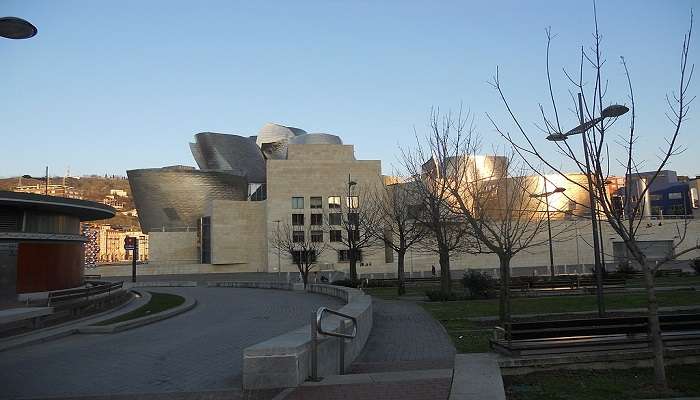
The Guggenheim Museum in Bilbao is an architectural marvel that has become a global symbol of contemporary art and design since its opening in 1997. Here are some intriguing facts about this iconic museum:
Designed by Frank Gehry: The museum has been designed by renowned architect Frank Gehry. The building is characterised by flowing organic shapes clad in titanium, glass, and limestone.
The Bilbao Effect: The revitalisation of the city of Bilbao, as well as a spur towards economic growth and urban renewal in the area, has become associated with the “Bilbao Effect.”
Innovative Use of Materials: Titanium cladding was chosen to cover much of the building because of its lightness and durability. It also gives the museum its signature shimmering surface.
Massive Art Installations: Inside the museum, large open spaces house large-scale installations and contemporary art pieces by Richard Serra and Jeff Koons.
Cultural Impact: As an artistic scene, the museum has proven popular, fostering many exhibitions, showings, and educational programs, and now sees millions of visitors annually.
Cost and Construction: It took only four years and cost $100 million, a lot of money for a museum, but it has paid off in terms of cultural prestige and economic impact.
Controversies: The museum had been a success, but it had also attracted criticism for the high cost of construction, and preoccupation with architecture rather than local cultural context, which stirred discussion on the status of such institutions in urban development.
Related Post: Churches In Seville
Guggenheim Museum In Bilbao Entrance Fees And Timings
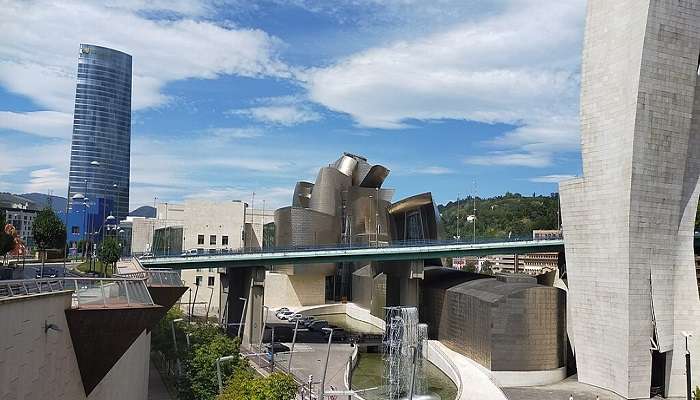
The Guggenheim Museum in Bilbao is open Tuesday through Sunday from 10:00 AM to 08:00 PM. It is closed on Mondays, except on December 23 and 30, 2019, when it operates during regular hours.
Entrance fees are structured to accommodate various visitors: adults pay €12, students aged 18-26, seniors over 65, and pensioners can enter for €6. Admission is free for children and youths under 18. These fees grant access to the museum’s impressive modern and contemporary art collection, ensuring a rich experience for all visitors.
How To Reach Guggenheim Museum?

Reaching the Guggenheim Museum in Bilbao is straightforward, thanks to various nearby public transportation options.
By Metro
The closest metro station to the Guggenheim Museum is Moyua Station. To access the museum, you can take the Ercilla-Guggenheim exit. From there, it’s just a short walk to the museum entrance, making it a convenient option for metro commuters.
By Train
If you prefer travelling by tram, you can get off at the Guggenheim Stop. This stop is conveniently located next to the museum, allowing easy access to its exhibitions and facilities. Due to its efficiency and proximity, the tram is a popular choice for locals and visitors.
By Bus
Several bus routes have stops within walking distance of the Guggenheim Museum, offering various options for reaching the venue. Routes 1, 10, 13, 18, and A7 lead to the Museo 1 / Henao stop, while routes 13, 27, 38, and 48 stop at Alda. Recalde 31 and 11, as well as Alda. Recalde 12. Re routes 11 and 71 also lead to the La Salve / Igogailua and Campo Volantín / La Salve stops. These bus routes provide excellent accessibility for those travelling throughout the city.
You May Also Like To Read: El Retiro Park
The Guggenheim Museum in Bilbao is a testament to the transformative power of art and architecture. Its striking design and world-class exhibitions have revitalised Bilbao and redefined what a museum can be. Whether you’re an art enthusiast, an architecture buff, or simply someone seeking inspiration, this iconic landmark promises an unforgettable experience that will leave you in awe. Ready to witness this architectural marvel and immerse yourself in cutting-edge art? Don’t miss the chance to explore the Guggenheim Museum in Bilbao and the vibrant culture of Spain. Book your trip to Spain today and prepare for a journey that will ignite your imagination and create lasting memories!
For our editorial codes of conduct and copyright disclaimer, please click here.
Cover Image Credit: Basotxerri for Wikimedia Commons
Frequently Asked Questions About Guggenheim Museum In Bilbao
What is so special about the Guggenheim Museum in Bilbao?
The Guggenheim Museum in Bilbao is famous for its groundbreaking architecture by Frank Gehry. Its curving titanium forms have made it a global icon of modern design.
What is the most famous painting in the Guggenheim Bilbao?
What is the concept of the Guggenheim Museum in Bilbao architecture?
Frank Gehry's design reflects deconstructivism. It blends fluid, organic shapes with industrial materials like titanium, glass, and limestone, symbolising innovation and modernism.
Is Guggenheim Bilbao worth it?
Yes, it's worth visiting. The museum's striking architecture, coupled with its exceptional collection of modern and contemporary art, makes it a unique cultural experience.
What is the controversy with the Guggenheim Bilbao?
People Also Read:
Karen Blixen Museum Lamu Museum Museum Of Siam

Unveil the hidden treasures of the globe and turn every travel dream into reality. As a Content Writer, I am passionate enough to craft stories from ancient wonders to modern marvels. My words paint the picture-perfect itinerary for unforgettable experiences. Let my words be your trusted guide to immerse in the diverse culture and discover the beauty of the unknown.











